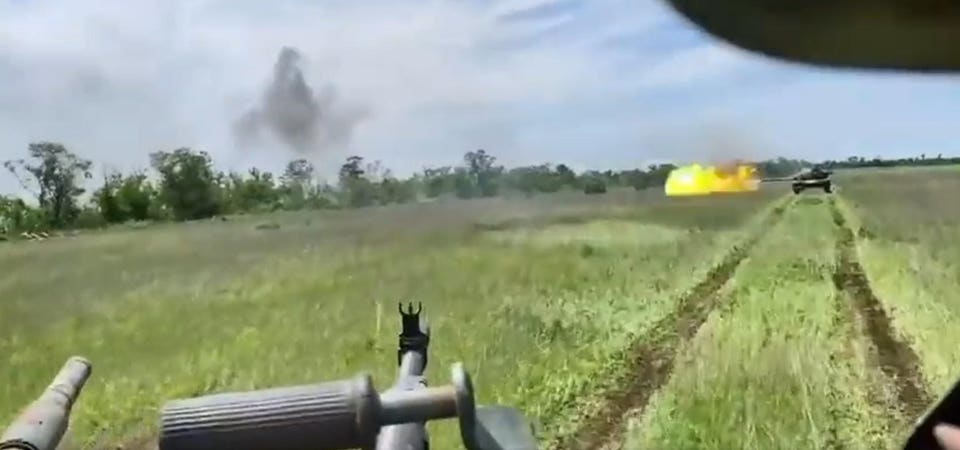A chain of drone and GoPro-style videos , shot by Ukrainian and Russian forces and posted on social media, depict an aggressive, creative assault by Ukrainian marines west of Makarivka near the Mokri Yaly river valley in late June. But the assault ultimately failed— and the videos hint at why . The marine infantry squads clearly outpaced their supporting tanks, leaving behind the heavy firepower they needed to hold onto their gains.
Ukrainian marines have improvised startling new tactics in their assault along the Mokri Yaly River in southern Donetsk Oblast. Those tactics have helped make the Mokri Yaly axis one of the most promising for the Ukrainians in their nearly six-week-old counteroffensive . But the tactics aren’t perfect.
In the case of the late-June assault, the unexpected appearance of a single Russian tank seems to have spoiled the attack. The Ukrainian marine corps’ 35th and 37th Brigades have led the attacks along the Donetsk axes of the ongoing counteroffensive. But the 35th and 37th are lightly equipped compared to Ukrainian army brigades.
A 2,000-person Ukrainian marine brigade typically rides in dozens of armored trucks supported by just a single company with 10 T-80BV or T-64BV tanks, whereas an army brigade might have a battalion of 30 or more tanks plus scores of tracked infantry fighting vehicles. The 37th Marine Brigade is even lighter than the 35th is. The 37th swapped out its tanks for wheeled AMX-10RC reconnaissance vehicles that weigh less than half what a tank weighs and are thinly protected.
What the marines lack in firepower and armor protection, they make up for with speed and aggression. Perhaps inspired by the U. S.
Army’s fast-moving armored “thunder runs” in Iraq in 2003, the 35th Brigade in particular aims to achieve surprise and shock in order to confuse and fracture dug-in Russian forces. The 35th Brigade assault that liberated Makarivka the second week of June illustrated these shock tactics. Marine vehicles formed a single column—Mastiff trucks followed by T-80 tanks followed by more Mastiffs—and rolled toward Makarivka along a dirt track.
The trucks speeded right past Russian trenches , leaving them to the tanks to suppress. But the tanks themselves fired on the move, their crews clearly understanding that the assault’s momentum mattered most. This confused and terrified the bypassed Russians.
“They didn’t expect such speed from us, going on Mastiffs,” one marine noted after the 35th rolled into Makarivka. The thunderous assault tactics worked in Makarivka. They didn’t work a week later when a battalion of the 35th Brigade attacked a Russian trench complex outside the liberated town.
The videos from the Ukrainian side underscore the speed and violence of the late-June attack. This time a company of marines advanced west in parallel columns north of a thick treeline stretching west from Makarivka—a treeline along which the Russians had dug a complex trench network. A dozen or so marine trucks formed the inner column.
A few tanks formed the outer column and aimed their 125-millimeter cannons through the gaps between the trucks. The two columns moved fast, firing machine guns and cannons into the treeline and ignoring Russian artillery and rockets exploding behind and beside them. The trucks moved fastest, however, reaching the far end of the trench complex ahead of the tanks.
The trucks halted and dropped their ramps—and marines piled out and stormed the trenches. The Ukrainians were in a position to roll up the Russian infantry in the trenches. But despite a single 35th Brigade truck posting up on the southern side of the treeline, apparently as a lookout, a Russian tank—a T-72 0r T-90, reportedly—managed to creep up the same side of the treeline toward the lead Ukrainian trucks and fire a 125-millimeter round through the trees and into one of the trucks.
The Ukrainians had more tanks on the field, but they were hundreds of yards short of the tank ambush at the western end of the trenchline. Abandoning their damaged truck, the marines did the cautious thing. They turned around and withdrew, as Russian videos of the skirmish clearly depict .
That the Ukrainians retreated doesn’t mean the assault was a waste. At the cost of a single truck and perhaps a few casualties, the 35th Marine Brigade wreaked havoc on a Russian fortification and gained some useful intelligence on the Russians’ disposition. But it’s worth noting that, three weeks later, it seems the Russians still hold that treeline west of Makarivka.
The Ukrainian brigades massing in the Mokri Yaly river valley lately have focused their assaults in the opposite direction, the east—and have managed to push back the Russians in this direction. The late-June treeline battle may have defined the limits of the Ukrainian marine corps’ shock tactics. A fast-moving vehicle assault might work when it’s synchronized—when the tanks keep pace with the trucks so that the trucks are never without heavy fire support.
If half the attacking force moves too fast, however, the entire assault can wreck itself on a single hard obstacle. In the case of the treeline operation, a solitary Russian tank whose crew wasn’t afraid to stand and fight a larger and faster Ukrainian force. .
From: forbes
URL: https://www.forbes.com/sites/davidaxe/2023/07/16/ukrainian-marines-use-shock-tactics-to-terrify-russian-troops-in-one-battle-it-took-just-a-single-russian-tank-to-end-the-shock/



